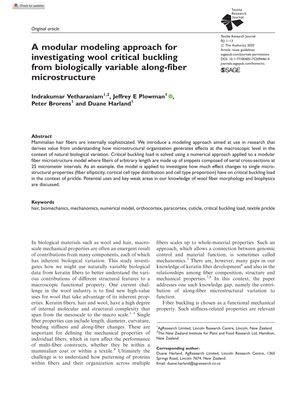TLDR The model helps understand how wool fiber structure affects its strength and flexibility.
The study introduced a modular modeling approach to investigate how the microstructural organization of mammalian hair fibers affects their macroscopic properties, specifically focusing on critical buckling load. Using a numerical approach, the model analyzed fibers composed of serial cross-sections at 25 micrometer intervals. The model was applied to assess the impact of changes in microstructural properties such as fiber ellipticity, cortical cell type distribution, and cell type proportion on critical buckling load, particularly in the context of prickle. The study also discussed potential applications and highlighted gaps in the current understanding of wool fiber morphology and biophysics.
13 citations
,
February 2019 in “Zoology” Lustre mutant sheep have normal hair structure and proteins but differ in felting properties.
41 citations
,
January 2018 in “Advances in experimental medicine and biology” 65 citations
,
March 2017 in “Experimental Dermatology” Curly hair is influenced by specific genetic variations.
34 citations
,
September 2007 in “Experimental Dermatology” The outer layer of Merino wool is rich in sulfur proteins, making it resistant to damage.
254 citations
,
January 2007 in “Chemical Society Reviews” Hair is a complex protein fiber with unique properties useful for developing hair products.

Polarized microscopy helps identify hair irregularities in genetic disorders.
November 2025 in “Journal of Natural Fibers” Human hair waste can be valuable in engineering and materials due to its unique properties.
 211 citations
,
June 2012
211 citations
,
June 2012 The skin is a complex barrier for drug penetration, but understanding its structure and interactions can improve drug delivery methods.
November 2025 in “Cosmetics” POLEVAN® improves hair shine, moisturizes the scalp, and maintains foam quality in shampoos.

TGF-β1 and FGF-18 are key in hair loss, and Minoxidil helps hair growth.



